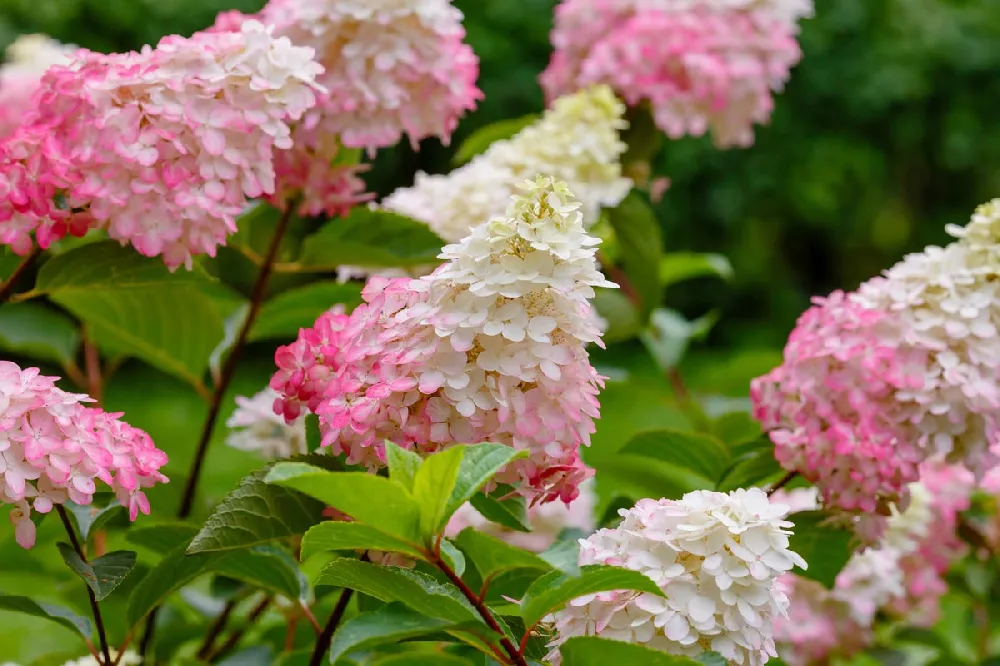Vanilla Strawberry Hydrangea for Sale - Buying & Growing Guide
- Ships in 1-2 days
- 1-Year Warranty Eligible
- Pots or accessories are not included unless specified in the product options.
Shipping Details:
Once your order is shipped, you’ll receive an email with a tracking number and estimated delivery date. Most orders ship immediately, but some items are seasonal and may only ship in spring or fall. These products are noted on the website.
The luscious vanilla strawberry hydrangea shrub, Hydrangea paniculata 'Renhy' PP20670, should make your mouth water — it's that lovely. Covered with large, showy flowers that last throughout the summer, it can be a centerpiece to your garden, offering great masses of color when planted in multiples. A panicle hydrangea, the flowers start out white and slowly deepen in color as the summer progresses, first to an attractive light pink then later to a deeper red-pink color. A single bush can have examples of all three colors on it at one time. At the end of the season, the flowers become parchment-like and provide winter interest throughout the cold months. If its irresistible flowers aren't enough reason to add one to your garden, here are a few more:
- The vanilla strawberry hydrangea is hardy throughout most of the continental U.S.
- It is a pollinator magnet that draws bees, butterflies, and hummingbirds to your yard.
- It is an easy-care plant that needs little extra attention or fussing over.
Plant Care
Sunlight

The vanilla strawberry hydrangea needs full sun in the north; partial shade in warmer regions.
Watering
Fertilize with a bloom-inducing product designed for landscape shrubs, such as a 10-20-10 formula.
Fertilizing

Feed when young with a balanced, slow-release fertilizer designed for landscape trees and shrubs.
Planting and Care
Planting instructions
Site your vanilla strawberry hydrangea carefully. If you live in a northern state (USDA hardiness zones 4 through 6), place it where it will get at least six to eight hours of direct light a day. In southern states (USDA hardiness zones 7 through 8), it will do better with light afternoon shade. It grows best in rich, well-drained soils, although it is not picky about soil type.
Unpot your hydrangea when ready for planting and tease out any encircling roots, which can girdle the tree and slowly kill it. Dig a hole that’s as deep as the root ball and twice as wide. Place the shrub in the hole, spreading out the roots. While holding it upright and steady, fill in around the roots with topsoil, tamping down as you go to eliminate air pockets. Water thoroughly. Apply a 2- to 3-inch layer of an organic mulch, such as bark chips, around the root zone, being careful that it does not touch the shrub itself.
Watering and nutrients
For the first growing season after planting, water your vanilla strawberry hydrangea every week, giving it an inch of water each time — or more if conditions are very dry or hot. In subsequent years, you can taper back on watering, giving it supplemental water only when you’re experiencing drought-like conditions. Fertilize your hydrangea with a slow-release, balanced product designed for landscape trees and shrubs or with a product that is higher in phosphorus, such as a 10-20-10 formula, to encourage blooms.
Pollination
The vanilla strawberry hydrangea has both sterile and non-sterile flowers, which are attractive to pollinators such as bees and butterflies. They are not naturally occurring shrubs but were created by horticulturalists in a controlled setting, and they will not grow true to seed.
Pruning
Prune your vanilla strawberry hydrangea in late winter or early spring, cutting back old wood to allow for new growth. Blooms occur on the current season’s growth, so thinning out older branches is necessary to encourage flowers. You should also monitor your shrub for broken, damaged, or diseased branches, which should be cut out whenever they are seen.
Pests diseases
The vanilla strawberry hydrangea isn’t bothered by many insect pests. Occasionally, you might see aphids or mites on the plant. If they become too numerous, try releasing beneficial insects, such as ladybugs and lacewings, to control them. Diseases of the hydrangea include bud blight, bacterial wilt, and leaf spot. Keep the area around your shrub clean of leaf litter and water at the roots rather than the leaves to help keep your bush healthy.
Achieving maximum results
The vanilla strawberry hydrangea is a versatile, sturdy plant, but you may not know that it is also easily grown as a container plant. Imagine a matched set of two on either side of the entrance to your patio, for example. A container-grown plant will probably not get as large as a garden-grown specimen, and they can be kept shorter with judicious trimming. Choose a container for your hydrangea that is about twice the size of the root ball, with good drainage in the bottom. Plant your shrub in a good-quality potting mix, and water thoroughly. Container-grown plantings need more watering than those in the garden, so keep an eye on your hydrangea, especially when it’s hot out. You will also need to feed it faithfully through the growing season. Every few years, you may want to unpot your hydrangea, trim back the roots, and refresh the soil.
FAQs
Where can I grow a vanilla strawberry hydrangea?
How big does vanilla strawberry hydrangea get?
When sited properly and well cared for, these hydrangeas can reach a height of 6 to 8 feet, with a width of 4 to 5 feet. If you are growing multiples, space them so that there are roughly 4 feet between each shrub. A vanilla strawberry hydrangea that is grown in a container may be somewhat smaller, as the roots will be constrained by the container they are in.
How are these shrubs best used in landscape settings?
Your vanilla strawberry hydrangea offers a spectacular floral display, so there are few places it would not be welcome. A massed setting of three or five shrubs together would make a great display in a front yard. An informal, unpruned hedge lining a boundary or patio would hold appeal throughout the summer months. Since they can handle some shade, they would work well in an airy woodland setting, but they would also not be out of place in a more formal garden.
Compare Similar Products
You can't add more Product Name - Product size to the cart.
OK









